Executive summary
This annual report provides a quality review of the quarterly euro area and national financial accounts.[1] The report fulfils the formal requirement obliging the ECB Executive Board to inform the Governing Council of the quality of these statistics, as set out in Article 7(2) of Guideline ECB/2013/24, of 25 July 2013 (as amended) (hereinafter the “ECB Guideline”). Furthermore, the report provides information supporting the Macroeconomic Imbalance Procedure (MIP) data quality assurance process as laid down in the “Memorandum of Understanding between Eurostat and the ECB/DG -S on the quality assurance of statistics underlying the MIP” (“the MoU”).
The main principles and elements guiding the production of ECB statistics are set out in the statistics quality framework (SQF)[2] and quality assurance procedures, published on the ECB’s website. This report therefore provides an analysis of the statistical data output, covering the elements of: (i) methodological soundness, (ii) timeliness, (iii) reliability and stability, (iv) internal consistency (completeness and validation of accounting restrictions) and (v) external consistency with four other comparable statistical domains (non-financial quarterly sector accounts, b.o.p./i.i.p., monetary financial institutions (MFI) balance sheet items, and securities issues statistics).
The descriptive and quantitative indicators used throughout this report are based on quarterly data that are available in line with the European system of accounts (ESA 2010). Data and revisions published up to 26 October 2018 are included. Supporting information tables and details of how the indicators are computed can be found in Annex 1 and Annex 2 respectively.
Given the specific requirements of the MIP and the responsibilities entrusted to the ECB in the context of the MoU, the box at the end of the report presents some indicators relating to the fitness for purpose of the data for all EU countries. The box draws on data up to end -2017 as transmitted in October 2018 and focuses on data availability, revisions, and the sources and methods relevant for the financial accounts data underlying the MIP indicators.
Statistical developments between 2017 and 2018
All euro area countries transmitted the mandatory data to the ECB and the data were generally timely and consistent. Countries provided quarterly supplementary data at t+85 and full national financial accounts data and metadata at t+97, as required by the Guideline. The provision of the mandatory metadata by all countries, in all full national transmissions, is an improvement on 2017. The voluntary transmission of metadata by countries which do not usually exceed the thresholds set by the Guideline is encouraged. This also applies to the supplementary transmission.
In terms of methodological soundness the national financial accounts are generally consistent with the requirements and conceptual framework of ESA 2010. However, the financial accounts statistics are derived statistics that rely on a wide range of data sources which are not necessarily complete or fully sufficient in terms of conceptual requirements. In such cases source data are supplemented with estimations or residual calculations, in order to ensure that the accounts are complete. Financial accounts data are therefore not necessarily the same as other datasets, and differences must be monitored and explained to users. The ECB encourages financial accounts colleagues to interact with their counterparts to reduce structural discrepancies and/or to reconcile differences between the datasets.
The methodological differences between the financial accounts and the balance of payments and international investment position statistics (b.o.p./i.i.p.) were removed with the introduction of ESA 2010 and BPM6. It is therefore critical that all countries follow the agreed steps, to ensure full consistency with the b.o.p./i.i.p.
The European System of Central Banks (ESCB) working groups on Financial Accounts (WG FA) and on External Statistics (WG ES), along with other sub-structures of the Statistics Committee (STC), are working closely together on the following common issues:
- securities held with non-resident custodians that are not covered by national securities holdings statistics;
- coverage of the other financial institutions (OFIs) sector and, in particular, the timely coverage of special-purpose entities (SPEs), given the lack of primary statistics;
- coverage of financial derivatives for all sectors, owing to missing data sources and/or counterpart sector details.
Known methodological issues and coverage gaps are shown in Table 1. The information is based on the regular data validation in the quarterly production rounds, discussions in the WG FA (and the WG ES), and the Committee on Monetary, Financial and Balance of Payments Statistics (CMFB) “level 3” quality reports that provide a self-assessment of national sources and methods.
Vertical consistency – i.e. consistency with non-financial sector accounts – is a further issue with scope for improvement, requiring the cooperation of financial accounts and non-financial accounts compilers. Vertical discrepancies are particularly large in relation to GDP in Belgium, Ireland, Greece, Slovenia and Finland.
On the basis of this report, a list of notable issues affecting euro area countries, as well as the scope for improvement, is provided in Table 1 below.
Notable issues and scope for improvement (euro area countries)
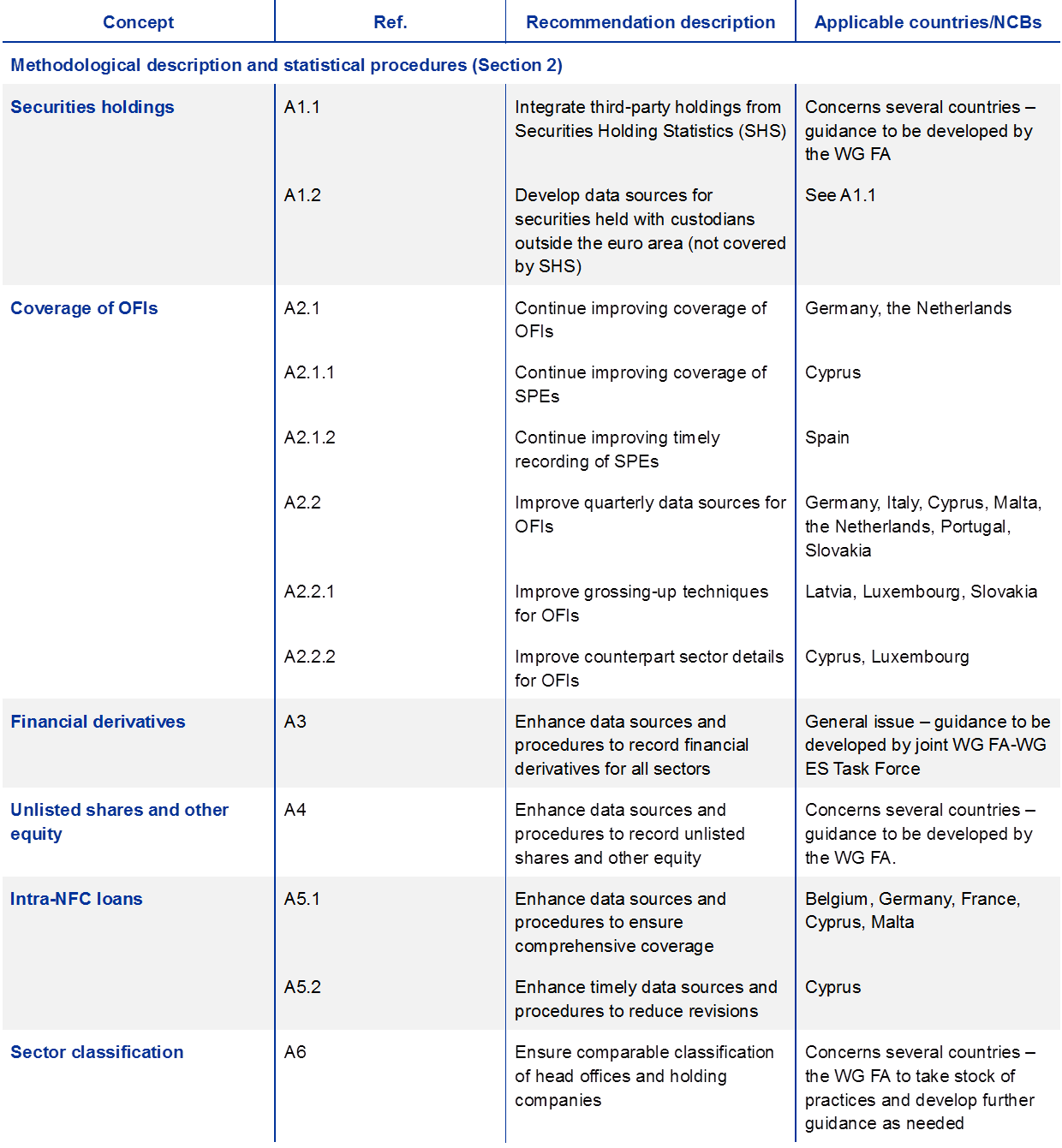
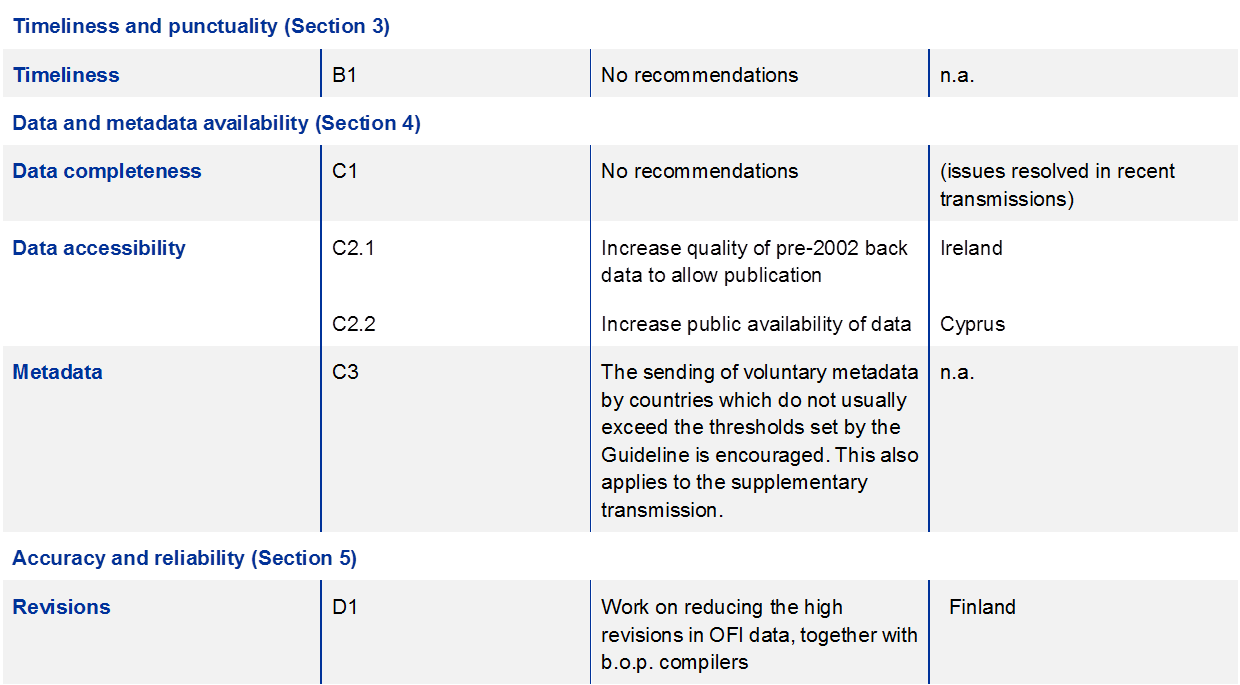

Statistical issues affecting MIP indicators
The ECB, in collaboration with Eurostat, has continued to monitor specific quality aspects of the statistical outputs, as required under the Memorandum of Understanding which addresses the quality assurance of statistics underlying the MIP. Given that the financial accounts are an integrated statistical accounting framework, most of the issues mentioned in the report are also relevant for assessing the quality of the data for MIP purposes. Furthermore, there are certain issues which affect the MIP data directly. In particular, items A5, A6 and G2 are important for private sector debt and credit flows, while items A2, A3, A4, A6, D1, G1 and G2 are important for financial sector liabilities.
One area where the compilation of the financial accounts data underlying the MIP indicators is particularly affected by limited data sources is the coverage of financial sector liabilities, in particular for SPEs and, more generally, OFIs, for which there are usually no timely and comprehensive source statistics available. Assessing and, where necessary, improving the quality of data for OFIs is a priority of the work on financial accounts. There are issues in many EU countries pertaining to the coverage and quality of the statistics for OFIs.
Cross-checking with business registers or the use of other methods to ensure full coverage should be improved in Germany, Cyprus (for SPEs), the Netherlands and Poland. While coverage is generally good in Spain, the time lag with regard to identifying new SPEs should be reduced. In the Czech Republic, Croatia and Sweden it is difficult to determine the coverage for particular OFI sub-sectors, groups of entities or instruments from the existing data sources, which indicates that the source data require specific improvements.
In most countries quarterly and annual financial accounts are fully consistent (see Annex 1 Table A.1.2.2). Vintage differences may occur as not all countries update their annual data on a quarterly basis. Countries are encouraged to ensure that quarterly and annual data are consistent, in particular for data vintages used for MIP purposes in October each year. Differences are relatively large in Ireland, Slovakia, Bulgaria, the Czech Republic and Denmark. In countries where the national central bank (NCB) is responsible for the quarterly financial accounts and the national statistics institute (NSI) is responsible for the annual frequency, close cooperation between the institutions usually means that differences can be minimised.
For MIP purposes the focus is on data for the last ten complete years. This data range is available for all EU countries except Denmark and Croatia, which are encouraged to increase the length of the relevant time series.
For more information on assessing data quality for MIP purposes please see the MIP box at the end of the main body of this report.
1 Introduction
This annual report provides a quality review of the quarterly euro area national financial accounts.[3] It fulfils the formal requirement obliging the ECB Executive Board to inform the Governing Council of the quality of these statistics, as set out in Article 7(2) of Guideline ECB/2013/24 (hereinafter the “ECB Guideline”).[4] Furthermore, the report is intended to provide information supporting the MIP data quality assurance as laid down in the “Memorandum of Understanding between Eurostat and the ECB/DG -S on the quality assurance of statistics underlying the MIP”. The report follows the recommendations adopted by the Committee on Monetary, Financial and Balance of Payments Statistics (CMFB) with regard to the harmonisation of the “level 2” quality report for b.o.p./i.i.p. statistics.[5]
The focus of the report is on national data for euro area countries and euro area aggregates. The data for all EU Member States (including non-euro area countries) are commented on in the MIP box at the end of the report and are also available in the annexed tables.
1.1 Scope of data coverage and structure of the report
This report analyses a number of aspects by which data quality can be measured. These include: (i) a review of methodological issues where national compilers diverge from statistical standards or need to enhance statistical procedures; (ii) an assessment of compliance by NCBs with their obligations to transmit data to the ECB, in terms of timeliness and coverage; (iii) the reliability of the statistical data; (iv) the internal consistency of the statistics; and (v) external consistency with other statistical domains/datasets (i.e. with non-financial sector accounts and b.o.p.) and comparisons with related financial statistics (i.e. MFI balance sheet statistics and securities issues statistics).
The analysis focuses on the quarterly financial accounts data transmitted and published in 2018. The dataset available as of 26 October 2018 was used throughout the report and, although the country coverage is the EU 28, the main body of the report only addresses the quality of data for the 19 countries of the euro area.
Given the specificities of the MIP process, some indicators on the fitness for purpose of the data are presented in a box at the end of the report for all European Union Member States. The box draws on data up to end -2017 as transmitted in October 2018 and revisions up to end -2016 and focuses on (i) data availability, (ii) revisions, (iii) consistency with non -financial sector accounts and sources and methods relevant for the financial accounts data underlying the MIP indicators, i.e. MIP-relevant quality dimensions. All indicators presented in the MIP box relate to the national GDP or outstanding amounts and are intended to facilitate the analysis relating to the actual MIP scoreboard indicators.
2 Methodological soundness and statistical procedures
The national financial accounts are generally consistent with the requirements and conceptual framework of ESA 2010. However, the financial account statistics are derived statistics that rely on a wide range of data sources, which are not necessarily complete or fully sufficient in terms of conceptual requirements. In such cases source data are supplemented with estimations or residual calculations in order to ensure the accounts are complete. An overview of the known methodological issues and coverage gaps is provided in Table 1 in the Executive summary. The information is based on the regular data validation in the quarterly production rounds, discussions in the Working Group on financial accounts (WG FA) and the CMFB “level 3” quality reports that provide a self-assessment of the national sources and methods.
Issues which concern many or all countries are described below. The WG FA has agreed on a tentative work plan to share best practices and develop guidance for these issues by 2019/2020.
2.1 Securities holdings
The coverage of the securities holdings of the sectors not previously covered by statistical reporting requirements – the non-financial sectors and most OFIs – has generally improved with the introduction of securities holdings statistics (SHS) which collect data from financial corporations and custodians. The national SHS must be complemented with data on residents’ securities holdings with custodians in other euro area countries and custodians outside the euro area. Holdings with custodians in other euro area countries are obtained from the third-party holdings of the euro area SHS and are increasingly integrated into the national data of the euro area countries.
Data from custodians outside the euro area are not generally available and countries have to use b.o.p./i.i.p data and other complementary sources. However, for these statistics it is often difficult to collect information on securities held by custodians abroad, especially with regard to households. The WG FA held a joint workshop with the WG ES on this topic in 2018 and is planning to work further on it in 2019. In particular, investigations will be conducted on the coverage of custodian data in respect of securities held by households via foundations or trusts and the feasibility of improving custodian data on the holdings of non-financial corporations or alternative sources.
2.2 Coverage of other financial institutions
Owing to the heterogeneity of OFIs, substantial parts of the OFI sector are not covered by euro area-wide statistical reporting requirements. The WG FA has continued to share information on ways to ensure the comprehensive and timely coverage of OFIs, and will continue to work on this issue in 2019. While most countries have developed, albeit to varying degrees, national surveys and other data sources, it remains a challenge to ensure that the data for the OFI sector has full coverage and is of high quality. A special questionnaire was administered by the WG FA in 2018 to gather information on the quality of the financial accounts for OFIs.
It is important to identify the complete population of the existing entities in a country to report comprehensive data for OFIs. This may be done via the information in business registers, which means these need to be complete and accessible by statistical compilers, and other comprehensive databases (e.g. balance sheet databases). Cross-checking with business registers or the use of other methods to ensure full coverage should be improved in Germany, Cyprus (for SPEs) and the Netherlands.
A further, common issue is the availability of timely quarterly data sources for OFIs that are suitable for compiling the financial accounts. Direct data sources are needed for instruments not covered by counterpart sector information (e.g. unlisted shares and loans). Germany, Italy, Cyprus, Malta[6], the Netherlands, Portugal and Slovakia are encouraged to improve their quarterly direct data sources. In Finland further work is needed to assure the appropriate level of coverage. While coverage in quarterly data sources is generally good in Spain, the time lag with regard to identifying new SPEs should be reduced.
When data coverage is not complete for certain OFI sub-sectors, groups of entities or instruments, full coverage may be achieved by estimating or grossing up the missing data using information obtained from existing annual data sources. Latvia[7], Luxembourg and Slovakia are encouraged to improve their grossing-up methods.
Counterpart sector details (e.g. on loans granted by OFIs) are incomplete and should be improved in Cyprus and Luxembourg.
2.3 Financial derivatives
It is particularly difficult to achieve coverage of financial derivatives for sectors not covered by statistical reporting requirements, i.e. the private sectors and large parts of the OFI sector, as these are generally not covered by custodian statistics. Financial accountants therefore generally rely on counterpart sector information, which may not provide sufficient information. The WG FA agreed to follow up on this issue in cooperation with the WG ES. In October 2018, a joint WG FA -WG ES Task Force on financial derivatives was formed with a mandate to issue recommendations on data sources and data collection and compilation methods. The Task Force is scheduled to provide its guidance in 2020.
2.4 Unlisted shares and other equity
Data sources for unlisted shares and other equity are incomplete in many countries, as corporate balance sheet databases may not fully cover privately-held corporations or quasi-corporations. Even when corporate balance sheet data are available, it is difficult to value unlisted shares and other equity in the absence of comparable corporations issuing listed shares. This is a potential explanation for the low values of unlisted shares and other equity in some countries relative to the distributed income of corporations. The WG FA has agreed on a stocktaking exercise aiming to evaluate the comparability of the recording and valuation practices; this work has been rescheduled to 2019 (as the start of work on securities held with non-resident custodians and on financial derivatives was brought forward to 2018).
2.5 Intra-NFC loans
Most countries lack a comprehensive and timely quarterly data source for loans between resident non-financial corporations (NFCs). Countries typically combine annual information from corporate balance sheet databases and business registers with more timely survey data and quarterly estimates, and the WG FA developed guidance for the comprehensive coverage of intra-NFC loans in 2011 -12. Several countries do not have a fully comprehensive direct data source or access to business registers facilitating the grossing-up procedures needed to achieve full coverage of intra-NFC loans. Cross-checking with business registers or the use of other methods to ensure full coverage should be improved in Cyprus. A further, common issue is the availability of timely quarterly data – Belgium, Germany, France, Cyprus, and Malta are encouraged to improve their timely direct data sources in order to reduce the revisions needed when comprehensive data become available.
2.6 Sector classification of head offices, holding companies and special-purpose entities
ESA 2010 introduced a change to the sector classification of head offices, holding companies and special-purpose entities (SPEs), which also affects the sector delineation of the financial and non-financial corporation sector. The WG FA agreed that in the context of the breakdown of OFIs by ESA sector, proposed as part of the medium-term strategy for financial accounts, further guidance will be needed to ensure the harmonised recording of the head offices of financial subsidiaries (S126), holding companies (S127) and SPEs.
3 Timeliness and punctuality
The ECB Guideline requires two transmissions: (i) the transmission of a sub-set of supplementary financial accounts data at t+85 to enable compilation of an integrated set of quarterly euro area financial and non-financial accounts, and (ii) the transmission of the full set of national financial accounts data at t+97.
All euro area countries transmitted the supplementary data and the full set of national data by the respective deadlines.
Table 2 below shows the dates of the financial accounts transmissions and data releases. National data are released by the ECB at t+108 (from April 2018). NCBs follow their own release policies.
Transmission and release dates in 2018 for euro area aggregates and country data

* Excluding the general government sector.
4 Data and metadata availability
4.1 Completeness
The data transmissions were complete, except for one issue which did not affect the compilation of either the euro area accounts or the MIP indicators. In the supplementary data transmission for Q1 2018 (t+85) the Netherlands did not transmit 20 mandatory counterpart sector series. The missing series were provided in the subsequent full national accounts data transmission (t+97).
The provision of metadata covering revisions and major events governed by the Guideline improved in 2018 in comparison with 2017. All countries regularly delivered metadata on revisions and major events, although Ireland was late transmitting the metadata for Q2 2018. The voluntary transmission of metadata by countries which do not usually exceed the thresholds set by the Guideline is encouraged. This also applies to supplementary transmission.
4.2 Accessibility
Accessibility refers to the conditions by which users can obtain, use and interpret data. This ultimately reflects how straightforward it is to access the data and the extent to which confidentiality constraints do not allow certain data to be shared.
The ECB publishes euro area aggregates for transactions, outstanding amounts and revaluations for all euro area aggregates. With regard to counterpart sector details, information is published on transactions and outstanding amounts for deposits, loans, debt securities, listed shares and investment fund shares. Revaluations are published for the holdings of listed shares and debt securities of the main resident sectors.
The ECB also publishes the national data made available by the NCBs. These include all transactions and outstanding amounts, revaluations for listed shares and debt securities, as well as domestic counterpart sector details.
The publication of national data by the ECB is stipulated in Article 3(2) of the Guideline, which requires the publication of all quarterly national financial accounts data except for the counterpart sectors “resident in other euro area countries” and “outside the euro area”.[8]
In line with this legal framework, all data must be sent to the ECB, flagging its confidentiality level. Table 3 below summarises the share of the time series marked as “free for publication” as the proportion to be published of the time series stipulated by the Guideline. Two datasets are distinguished. The transmission of the first, “core” dataset has been mandatory since October 2014 and comprises assets and liabilities by institutional sector (Guideline Annex Tables 1 and 2) as well as the who-to-whom (or “counterpart sector”) tables for deposits and short-term and long-term loans (Guideline Annex Tables 3 to 5). A minimum range of back data, starting from reference quarter Q4 2012, has been mandatory since October 2014. Additional back data (Q1 1999 – Q3 2012) became mandatory with the October 2017 transmission. The second dataset comprises the counterpart sector details for securities (Guideline Annex Tables 6 to 9), starting from the first reference quarter Q4 2013; its transmission became mandatory in September 2016.
Share of observations marked as “free for publication” per dataset for euro area countries, in percentages
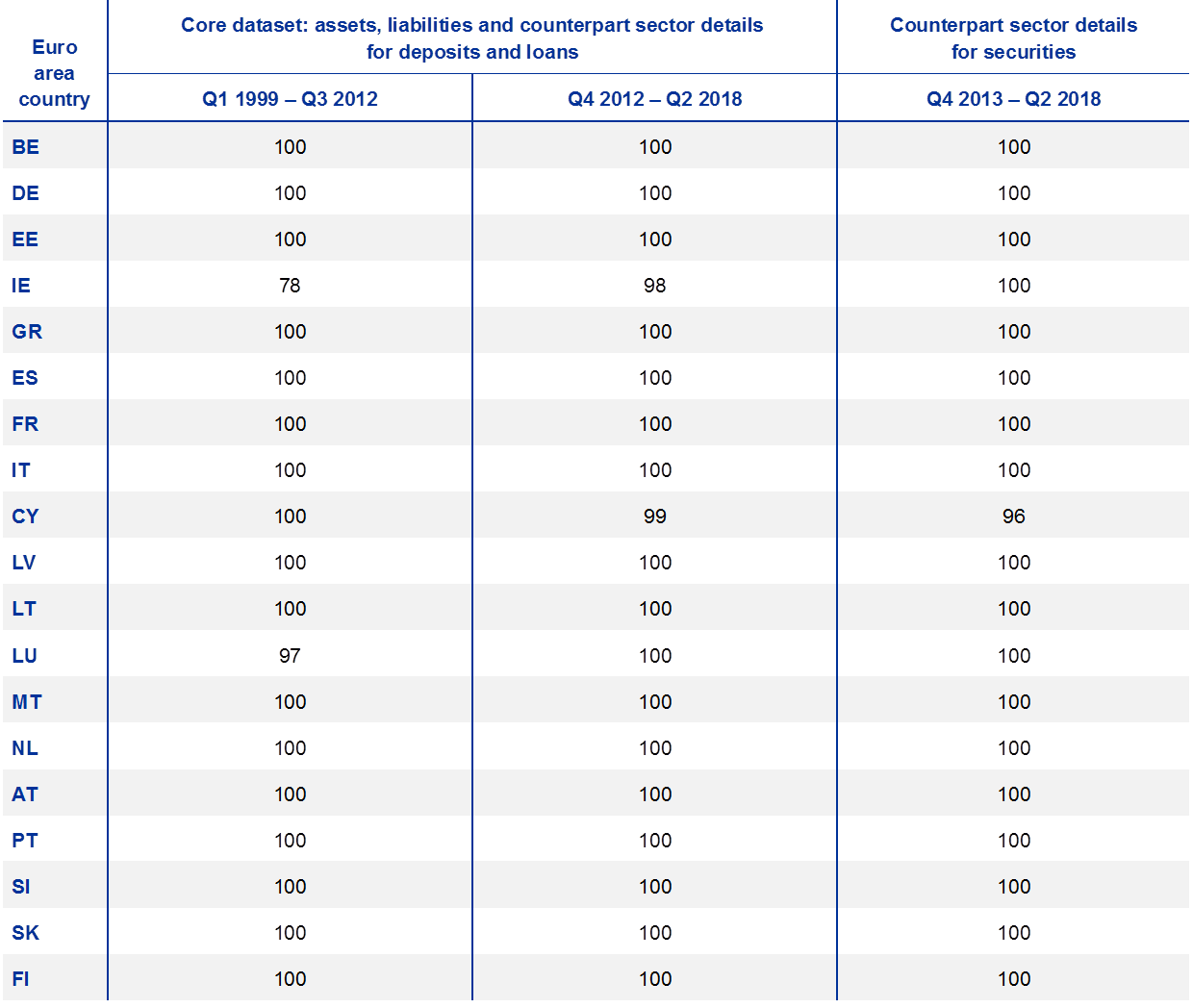
Most euro area countries make the entire datasets publicly available through their transmission to the ECB’s Statistical Data Warehouse. Ireland releases the required counterpart sector details for securities, although only 78% of the observations relating to the additional back data for the core dataset are fully available, as parts of the data prior to Q1 2002 (and the separate household and non-profit institutions serving households (NPISH) sub-sectors from Q4 2012) are flagged as “not for publication”. In the case of Cyprus, the partial non-availability of more recent data and counterpart sector details is due to primary and secondary confidentiality constraints in the b.o.p./i.i.p. source data. There was slightly reduced publication of the back data for the core dataset for Luxembourg (for the insurance corporations and pension funds sub-sectors and counterpart sectors) during 2018 owing to confidentiality constraints.
4.3 Clarity
Clarity refers to the “information environment” of the data, i.e. whether the data are accompanied by relevant and pertinent metadata, illustrations (such as charts), information on their quality and potential limitations as to their use, and background information (sources and methods).
The availability of background information on sources and methods considerably enhances the usability and clarity of the data.
The ECB publishes two press releases per quarter, outlining the latest data and relevant economic developments, on the ECB’s website. The dissemination dates for all press releases are announced at the beginning of each calendar year in the ECB’s Statistical Calendars.
The concepts and definitions used in the quarterly financial accounts are in line with international statistical standards and, in particular, ESA 2010. Background information explaining the link between the financial accounts and the non-financial accounts, and providing further methodological information, is available at the Sector accounts section of the ECB’s website.
The euro area aggregates and the national data can be accessed via the ECB’s Statistical Data Warehouse or in the section in the Statistics Bulletin on sector accounts. Furthermore, the ECB publishes a large set of euro area and country charts for the household sector in its quarterly Household sector report.
The ECB has a Statistical Information Request facility for external statistics users which helps them access and analyse the data.
A sub-set of the statistics produced under the ECB Guideline can also be accessed via the Euro area statistics website. The aim of this website is to facilitate the understanding, use and comparison of euro area and national statistics by presenting the statistics in a user-friendly manner. Another feature of the website is that it allows who-to-whom data to be easily viewed in interactive graphics which can be downloaded onto other websites, in emails or on social media.
This quality report on financial accounts is published every year, starting from 2018. Quality reports on euro area data were previously published on a biennial basis.
Table A.1.1.1 in Annex 1 presents a summary of the national practices regarding data and metadata accessibility. All euro area countries allow users to download data in different formats. Belgium, Germany, Estonia, Ireland, Spain, France, Cyprus, Lithuania, the Netherlands, Portugal and Finland have a quarterly press release. The majority of euro area countries (except Greece and Luxembourg) have Statistical and/or Economic Bulletins that provide a visual representation of the data in the form of charts, graphs and tables. Countries should strive to provide a single point of contact for queries from data users – this feature is not yet available in Slovakia.
The CMFB level 3 quality or “self-assessment” reports that provide metadata on national financial accounts (including descriptions of compilation practices, sources and methods) are published on the national and/or the CMFB’s website. The CMFB's section on Quality reports concerning statistics underlying the MIP indicators has links to the reports from all 28 EU countries. The reports were updated by all countries during 2018.
5 Accuracy and reliability
This section reviews the stability of the data in terms of revisions to the initially compiled data (“first assessment” or “first vintage”). In general, revisions are needed to improve the accuracy of the data, as an initial assessment may be based on incomplete, late or erroneous responses from reporting agents. However, large recurrent revisions may indicate that the data collection and/or compilation process is of comparatively low quality, a situation which needs to be addressed. On the other hand, if there are minimal or no revisions this does not necessarily mean that the first assessment was of high quality – it may simply indicate a national preference for not revising the data.
In this report, revisions for all euro area countries and for the euro area as a whole are assessed using indicators based on a comparison between the initial and the final assessment. Two basic types of indicators are used (more detailed information on revision indicators is available in Annex 1).
- Relative size indicators measure the absolute differences between the first and the most recent data vintages. The absolute differences may be quantified relative to the underlying series when strictly positive or, otherwise, to a reference series such as GDP or underlying outstanding amounts. These indicators are the symmetric mean absolute percentage error (SMAPE) and mean absolute revisions shown as a percentage of GDP. In the case of transactions, revisions cannot be properly related to the series value itself because the observations may have different signs or the value of the series may often be close to zero. Therefore, absolute revisions in transactions are related to the underlying outstanding amounts or to an individual country’s GDP.
- Directional stability and reliability indicators measure how frequently initial assessments are revised in the same direction and whether the direction of change indicated by the initial assessment has correctly predicted the direction of change in the most recent data vintage.
All revision indicators are calculated using quarterly data for reporting periods from Q2 2016 to Q1 2018 for national and euro area aggregates, as shown in the charts throughout this section. The analysis focuses on the main financial accounts indicators as commented on in the ECB’s euro area accounts press releases in relation to household financial investment, as well as household and non-financial corporation financing. Financial sector liabilities are also presented, as this is the basis for the third MIP headline indicator. The revision indicators are shown for euro area aggregates and country data. The median values for the countries are presented to facilitate a comparison across countries. Detailed tables containing SMAPE, upward revisions and directional reliability indicators for the euro area aggregates and all EU countries are available, for information purposes, in Annex 1. When comparing revisions of country data and euro area aggregates, due consideration should be given to the fact that offsetting revisions in country data may imply lower revisions at euro area level.
5.1 Household financial investment and loan financing
Revisions to household financial investment were more pronounced than revisions to household loan financing in all euro area countries, except in Luxembourg, Malta and Austria, as can be seen in Chart 1.
Euro area household financial investment (transactions) recorded revisions that are lower than the median for revisions of euro area countries. Directional reliability (Annex 1 Table A.1.3.4) was 88%. Malta revised household financial investment data more extensively than other countries, due to a one-off revision in one quarter; the median for all euro area countries for the reference period was 0.1%. Furthermore, Malta showed levels of directional reliability of below 70%, with a balanced distribution of upward and downward revisions.
Euro area household loan financing (transactions) recorded a lower level of revisions compared with the euro area countries’ median and directional reliability of 100%.
Malta and Luxembourg recorded a higher level of revisions of household loan financing compared with other euro area countries – the median of all euro area countries for the reference period was 0.03%. Directional reliability was below 70% in the case of Malta, with a balanced distribution of upward and downward revisions.
Revision to household financial investment and loan financing (transactions)
(Symmetric mean absolute percentage error (SMAPE), Q2 2016 – Q1 2018)

5.2 NFC financing
Of the components of NFC financing, the net issuance of debt securities was revised more than loan financing in six euro area countries, as can be seen in Chart 2.
For both loans and debt securities the euro area as a whole exhibited a slightly lower level of revisions than the median for euro area countries. Directional reliability was 75% for debt securities and 88% for loan financing. For the net issuance of debt securities, revisions were particularly high for Cyprus and Lithuania, with Cyprus exhibiting values of below 70% for directional reliability. For Cyprus, the large amount of revisions in percentage terms was due to very low absolute values of securities issuances, so the directional reliability indicator is less informative.
Belgium, Luxembourg, the Netherlands and Finland recorded higher than average revisions to NFC loan financing than the other euro area countries, while the directional reliability indicator was not below 70% in any of these countries.
Revisions to NFC financing (transactions)
(Symmetric mean absolute percentage error (SMAPE), Q2 2016 – Q1 2018)

5.3 Financial corporations liabilities
With regard to revisions to financial corporation (FC) liabilities (stocks), the euro area as a whole recorded revisions of 0.1% of the underlying stocks during the period observed, which is significantly lower than the 0.4% median for the euro area countries, as a large number of (smaller) countries recorded high revisions (see Chart 3). Revisions for all financial corporation sub-sectors were relatively low, with the highest revisions in the OFI sector, for which the aggregated euro area revisions were 0.6% (while the euro area median was 1.5%). Directional reliability for euro area FC liabilities stood at 100%.
Revisions for FC liabilities were highest for Cyprus, Luxembourg, the Netherlands and Slovakia but were lower overall for total FC liabilities and OFI liabilities than the data reported in the previous Quality Report in June 2018 for most countries. Directional reliability was only below 70% in the case of Cyprus. Luxembourg consistently revised all first releases upwards, which was explained by ongoing improvements in the coverage of SPEs, while the Netherlands consistently revised all first releases downwards, which was explained by the reclassifications of a large number of OFI entities to the NFC sector in the benchmark revision in 2018. Revisions to OFI liabilities were high in about half of the euro countries (see Chart 3) and were therefore a main driver of revisions to overall FC liabilities. They were especially high in Finland, due to revisions to the balance of payments data.
Revisions to financial corporation liabilities (stocks)
(Symmetric mean absolute percentage error (SMAPE), Q2 2016 – Q1 2018)

Detailed tables containing SMAPE, upward revisions, directional reliability indicators and mean absolute revisions as a percentage of GDP for all EU countries are available in Annex 1.
6 Internal consistency
Internal consistency refers to accounting identities and to hierarchical relationships between aggregates and components.[9] This includes horizontal consistency, which is defined as equality between the sum of (transactions in) financial assets and the sum of (transactions in) liabilities for each financial instrument (i.e. the sum of listed shares issued by the resident sectors and the rest of the world equals the sum of listed shares purchased by the resident sectors and the rest of the world).
The euro area accounts are not a simple aggregation of the national data, as they need to be combined with other euro area statistics (in particular euro area b.o.p./i.i.p. and MFI balance sheet statistics) to obtain genuine euro area accounts. Horizontal consistency is not generally maintained when all these components are put together, owing to discrepancies across data sources. The resulting imbalances between assets and liabilities for each transaction are then resolved by leaving data from the most reliable sources unchanged and amending data from less reliable sources, as appropriate.
The apparent horizontal imbalances (before data sources are reconciled) in the euro area financial accounts continued to be significant. The two underlying causes of this are b.o.p./i.i.p. asymmetries[10] as well as differences between national financial accounts data and euro area building blocks. The latter occur mostly because national financial accounts compilers may adjust the statistics underlying the euro area building blocks or may use different data sources. For example, loans granted by MFIs to general government, as recorded in the financial accounts, may differ from the data in MFI balance sheet statistics because financial accounts compilers use government finance statistics. These are assumed to provide higher-quality identification of the borrowing entities classified in the government sector (while reporting MFIs may sometimes misclassify entities such as local utility service providers as part of government).
Table 4 shows the euro area horizontal imbalances resulting from the combination of the various data sources, i.e. before the balancing process, in the 26 October 2018 release.
Internal consistency of input data for the euro area accounts by financial instrument
Horizontal imbalances
RMSE (EUR billions) broken down into bias component █ and variance component █Increase (↑), no change (↔) and decrease (↓) in the indicator compared with its value one year ago)
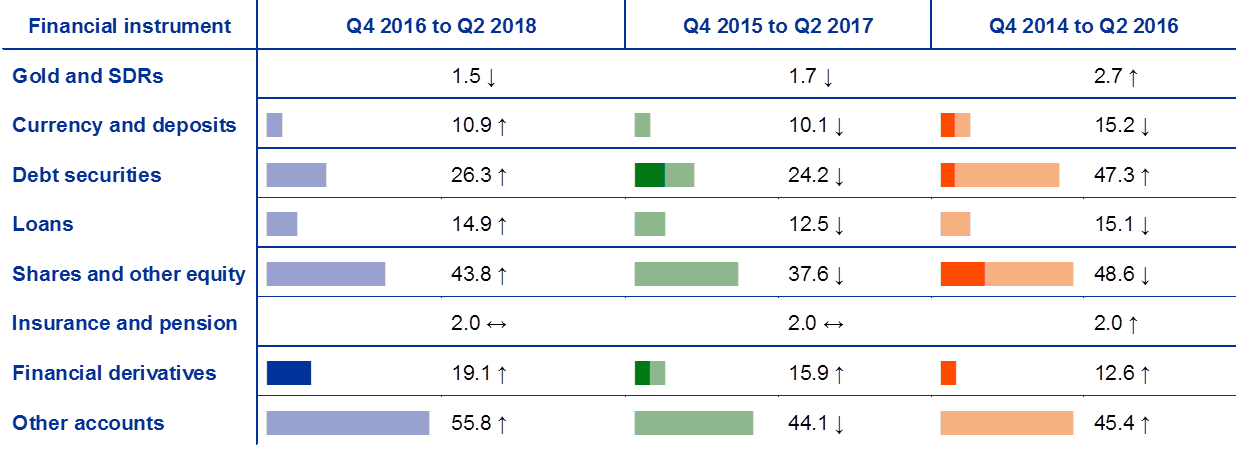
The inconsistency of euro area aggregates before balancing increased for most instruments compared with the transmissions in the same quarters one year previously (second column). The inconsistencies averaged out over time for all instruments except financial derivatives. The inconsistency of financial derivatives is biased owing to an excess of liabilities over time, which stems from the larger net liabilities vis-à-vis the rest of world recorded in the national financial accounts compared with the euro area balance of payments (see also Section 7.2)
The national financial account datasets as transmitted to the ECB (i.e. the country datasets after balancing by national compilers) are internally consistent, except for minor issues that do not affect the main indicators.[11] Some internal inconsistencies remain for Ireland related to aggregation checks, mostly for other changes in volume (see Annex 1 Table A.1.2.1). Ireland reported a number of who-to-whom series with negative stock (balance sheet) data for deposits (two) and loans (five). Germany reported two who-to-whom time series with negative stock data for loans. Estonia reported one other equity series with negative values in line with the data recorded in external statistics (international investment position) and Portugal reported one series (unlisted shares) with negative stocks.[12]
7 External consistency/coherence
7.1 Coherence with non-financial sector accounts: vertical consistency
The ECB, in cooperation with Eurostat, produces integrated financial and non-financial accounts which are published as the quarterly euro area accounts. Full coverage of instruments facilitates the compilation of certain balancing items, such as net lending/net borrowing (from the non-financial accounts) and net financial transactions (net acquisition of financial assets minus the net incurrence of liabilities, or net lending/net borrowing as derived from the financial accounts). It also enhances “vertical reconciliation” (equal balances for financial and non-financial accounts), both within euro area institutional sectors and with regard to the rest of the world. Currently, the euro area accounts comprise fully vertically integrated data for the FC and general government sectors while, for the NFC and household sectors and the rest of the world, there are vertical discrepancies between the financial and the non-financial accounts.
Vertical imbalances arise because different data sources are used for the compilation of the financial and the non-financial accounts. The discrepancy for the rest of the world is closely related to the “net errors and omissions” stemming from the b.o.p. For the euro area accounts, the vertical discrepancies resulting from the national data and euro area building blocks are reduced (and are completely eliminated in the case of financial corporations and government) by the effect of source selection criteria (which is sensitive to consistency considerations) and data adjustments made on the basis of expert judgement and mathematical methods.
Some countries have established similar policies to eliminate the discrepancies, e.g. by adjusting financial and/or non-financial items for which the data sources are considered to be incomplete or of poor quality, while others do not make such full “reconciliation” adjustments, in order to preserve the information from the respective data sources. All countries, however, are seeking to reduce the sources for discrepancies, by improving source data and balancing processes. Furthermore, joint discussions by non-financial and financial account compilers at national and European level (WG FA and the Expert Group on Sector Accounts) address the topic.
The charts below present the vertical discrepancies for the resident private sectors. For countries with a GDP of below 1% of the EU total, the transmission of quarterly non-financial sector accounts is not mandatory for resident sectors other than government. The vertical consistency of quarterly data cannot, therefore, be assessed for Estonia, Cyprus, Latvia, Lithuania, Luxembourg, Malta and Slovakia, while Slovenia provides quarterly data on a voluntary basis.
Charts 4.1.a, 4.2.a and 4.3.a present the absolute vertical discrepancies as of the October following the respective years, in order to focus on the development over time (i.e. the vertical discrepancy for 2017 shows the data as available in October 2018, which is broadly comparable with the vertical discrepancy for 2014, as available in October 2015).
Charts 4.1.b, 4.2.b and 4.3.b show the cumulative vertical discrepancies as available in October 2018, in order to show whether vertical discrepancies balance out or accumulate over time. Accumulating vertical discrepancies indicate a persistent bias in the accounts.
For households there was a decrease in the differences between the financial and the non-financial accounts for the euro area (see Chart 4.1.a). The differences were small in all four years (only in 2014 was the difference above 0.5% of GDP). Some countries (Germany and Portugal) reconcile the household sector, e.g. by adjusting financial and/or non-financial items for which the data sources are considered incomplete or of relatively low quality; other countries do not make such reconciliation adjustments. In France the reconciliation exercise is conducted once a year, as balance sheet data are revised on an annual basis. In many countries vertical discrepancies tend to largely offset each other over time and, as a result, the four-quarter averages are low in most countries. Discrepancies relative to country GDP for 2017 were particularly high for Greece, Slovenia and Finland.
Vertical discrepancies, households
(Absolute vertical discrepancies relative to GDP, percentages)
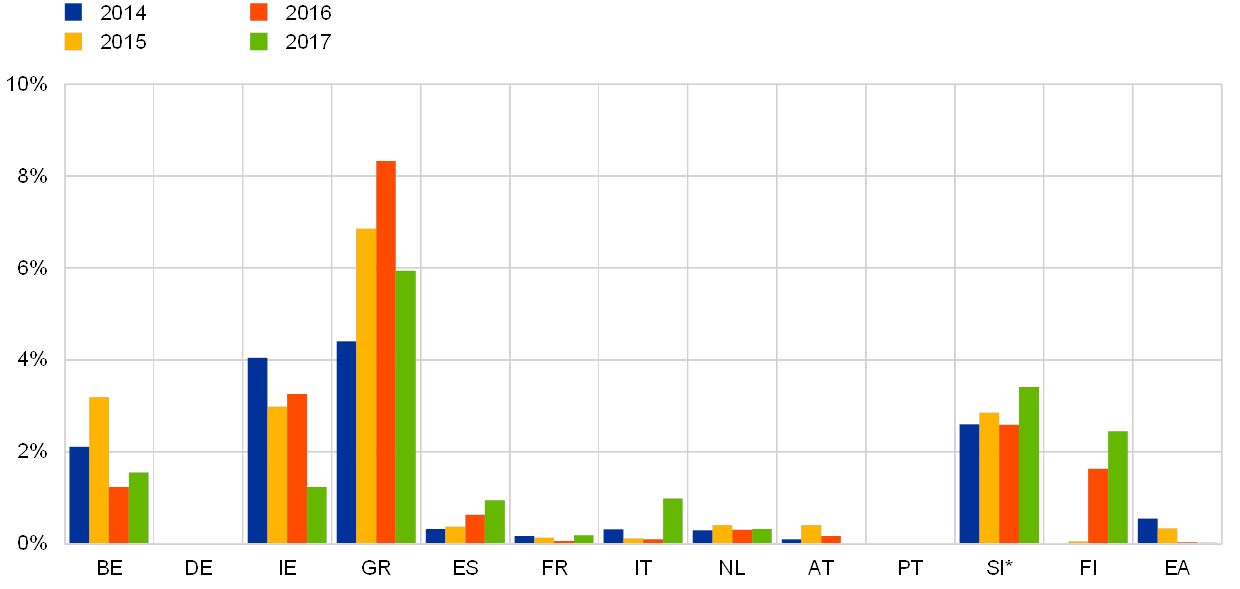
* Slovenia provides data on a voluntary basis.
The sign persistency of the vertical discrepancies is also a relevant quality measure, as it helps to identify biases in the accounts (neglecting short-term volatility and recording issues between consecutive quarters). Chart 4.1.b below displays the cumulative vertical discrepancies for the household sector in relation to GDP. The euro area household sector displays a very small negative bias. Countries with high absolute discrepancies also exhibit persistent biases in the accounts: a negative bias is shown for Greece and Finland while a positive bias is observed for Slovenia. A positive bias indicates the continued excess of net lending, as derived from the non-financial accounts (and vice versa for a negative bias).
Bias in vertical discrepancies, households
(Cumulated vertical discrepancies relative to GDP, percentages)
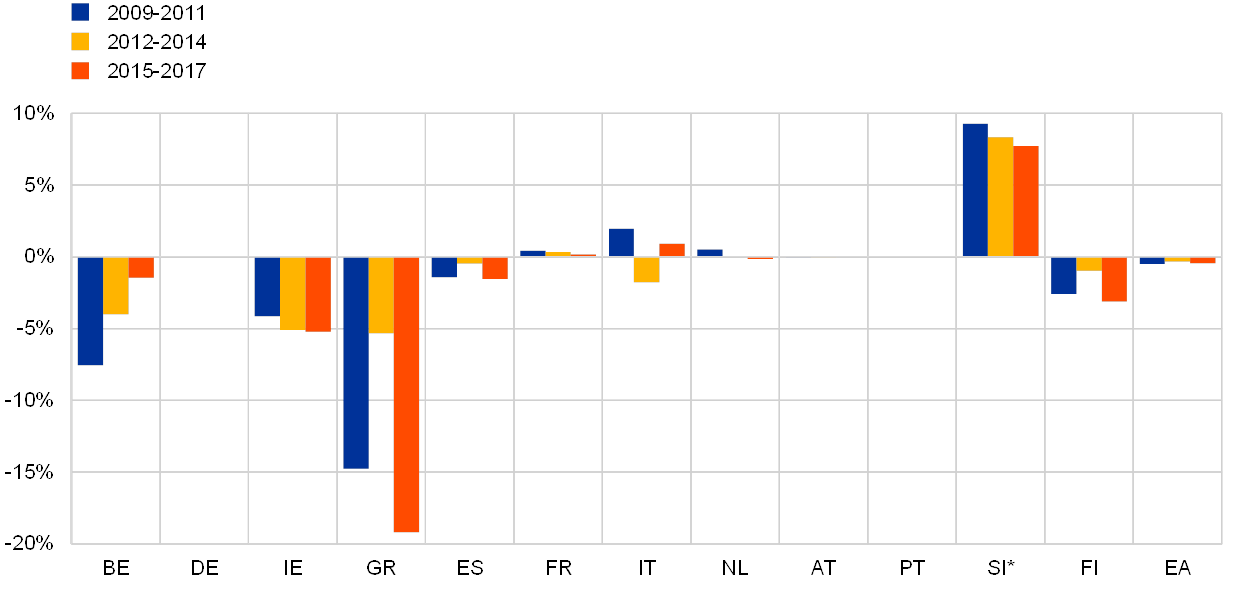
* Slovenia provides non-financial sector accounts for this sector on a voluntary basis.
For NFCs there was a decrease in the differences between the financial and the non-financial accounts for the euro area to virtually zero in 2017 (see Chart 4.2.a). For some countries, the discrepancies were significantly greater, partly because this sector is generally not reconciled (see Chart 4.2.a). In some countries (e.g. Germany), this sector has been chosen to offset the “net errors and omissions” stemming from the b.o.p. There have been significant improvements on previous years in Ireland, which has a large NFC sector relative to GDP owing to the presence of large multinational corporations, and Greece. In both cases this mirrors a similar improvement in the household sector. Discrepancies relative to country GDP for 2017 were particularly high for Belgium, Ireland, Greece and Finland.
Vertical discrepancies, non-financial corporations
(Absolute vertical discrepancies relative to GDP, percentages)
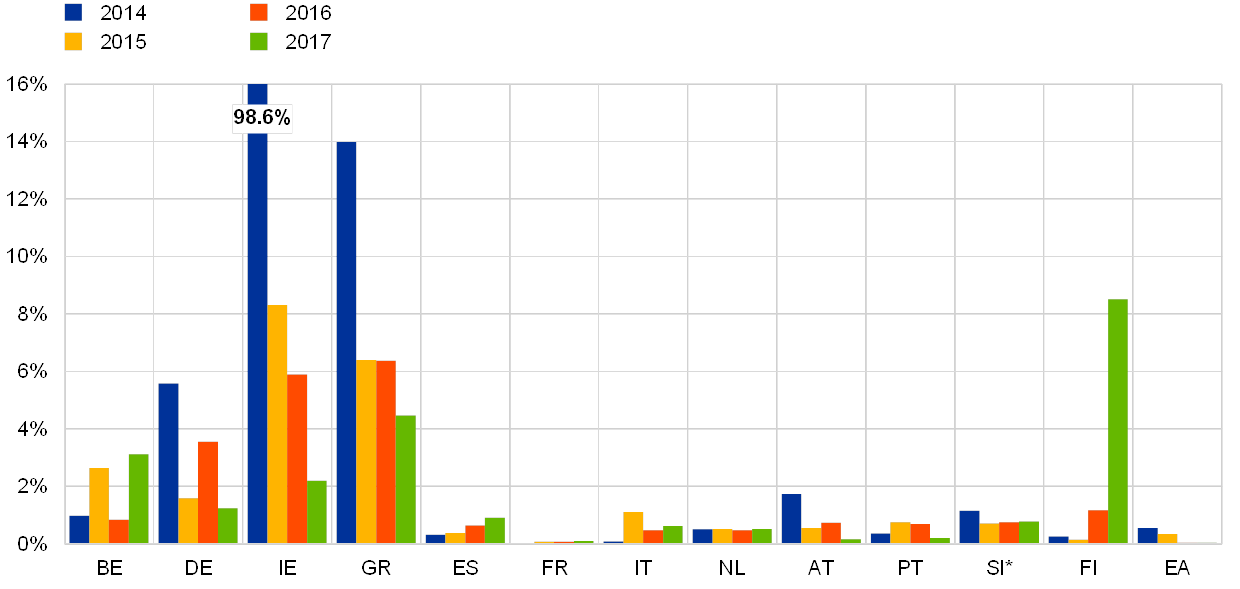
* Slovenia provides non-financial sector accounts for this sector on a voluntary basis.
The euro area NFC sector displays a small positive bias (see Chart 4.2.b). Ireland displays a negative bias in the most recent period, while Greece and Finland show a positive bias for all periods.
Bias in vertical discrepancies, non-financial corporations
(Cumulated vertical discrepancies relative to GDP, percentages)
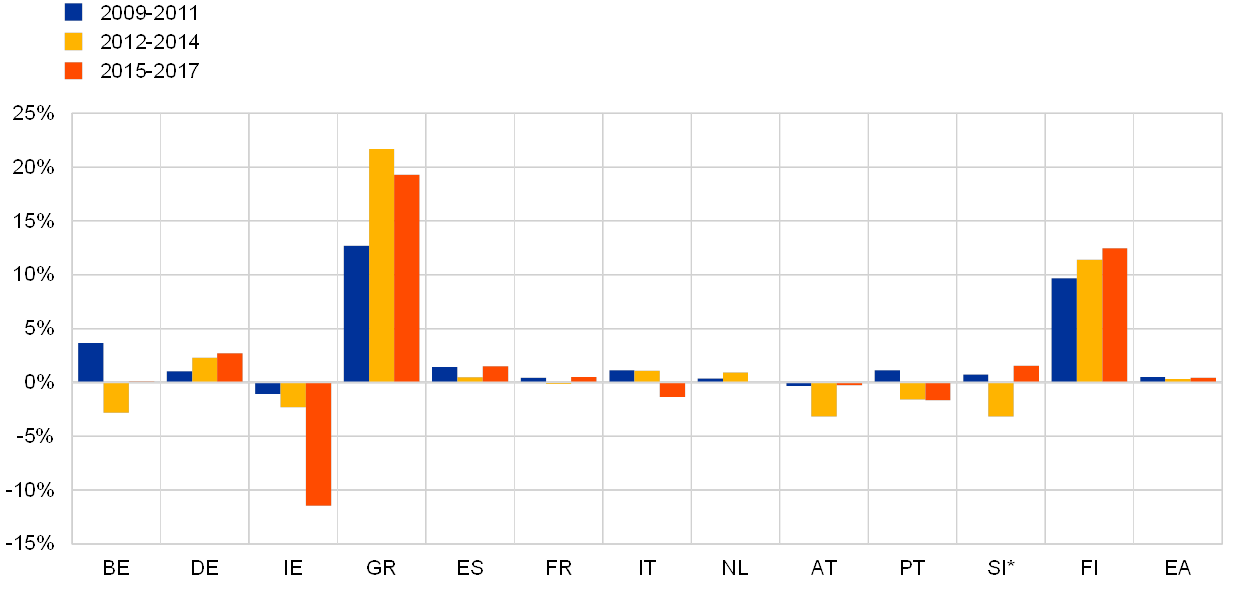
*Slovenia provides non-financial sector accounts for this sector on a voluntary basis.
The euro area financial corporations sector is fully reconciled (see Chart 4.3.a). For this sector, data availability is typically better than it is for the non-financial sectors, and many countries usually achieve consistency. Discrepancies relative to country GDP for 2017 were relatively high for Finland and Ireland. In the case of Ireland the discrepancies have decreased and are now relatively small compared with the size of the financial sector.
Vertical discrepancies, financial corporations
(Absolute vertical discrepancies relative to GDP, percentages)
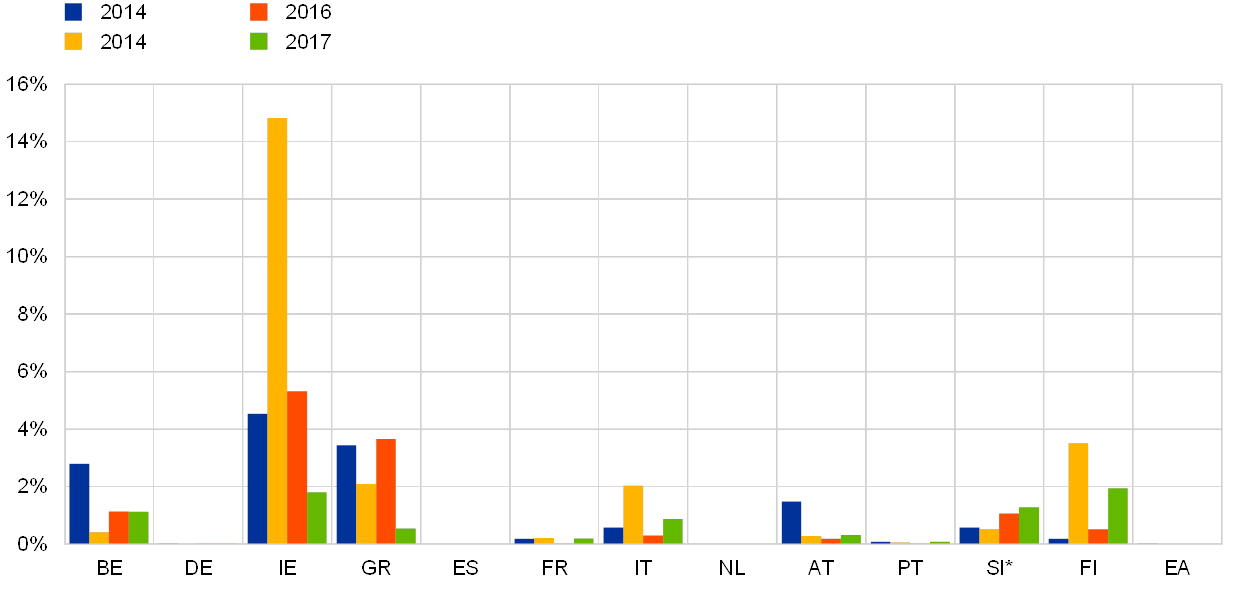
* Slovenia provides non-financial sector accounts for this sector on a voluntary basis.
Ireland and Finland exhibit a negative bias, while Greece displays a positive bias in the most recent period (see Chart 4.3.b).
Bias in vertical discrepancies, financial corporations
(Cumulated vertical discrepancies relative to GDP, percentages)

* Slovenia provides non-financial sector accounts for this sector on a voluntary basis.
7.2 Consistency with balance of payments and international investment position statistics
Euro area b.o.p. and i.i.p. data constitute one of the so-called building blocks for euro area financial accounts and are widely used at national level for the compilation of the rest of the world (RoW) financial and non-financial accounts as part of the system of national accounts.
The methodological differences between b.o.p./i.i.p. and the RoW account (national accounts) were removed with the introduction of ESA 2010 and BPM6, even though some interpretation challenges still remain.[13] However, the analysis shows that inconsistencies between the two statistical domains persist in several Member States, negatively affecting the combined use of the two datasets and their reliability. Acknowledging this, the ESCB has worked to precisely identify the differences and to develop national medium-term work plans to be generally observed by September 2019.[14] In this context, the removal of inconsistencies between the two statistical domains is progressing in the EU and some countries already compile the two sets of statistics in a consistent manner.
7.2.1 Financial transactions
Chart 5 shows the differences between b.o.p. and the RoW account for financial transactions. In this case discrepancies may be accounted for by timing differences in the recording as well as the reconciliation of the national sectoral accounts; both the “vertical” reconciliation (a correction for errors and omissions) and the “horizontal” reconciliation (asset/liability equality across sectors) may entail larger adjustments to the financial transactions of the RoW account. Nonetheless, according to a convention agreed by balance of payment compilers, the relative differences should not exceed 0.3% of the average value of the underlying positions.
For the euro area as a whole the differences were not significant (smaller than last year for assets and broadly unchanged for liabilities) and showed a relatively high level of consistency between the two datasets. At country level differences of above 0.3% were recorded for several countries (Germany (only for liabilities), Greece (only for assets), France (only for liabilities), Slovakia and Finland). Slovakia and Finland recorded the highest relative discrepancies while the largest absolute differences were observed in Germany, Ireland and France.
Financial account transaction discrepancies between the b.o.p and RoW account
(average absolute and relative difference (as a percentage of respective b.o.p and RoW stocks of financial assets/liabilities) for the period Q3 2015 to Q2 2018 (b.o.p. vs EAA))

Source: ECB.
7.2.2 Financial positions
Chart 6 below presents the differences between the i.i.p. and the RoW account for financial assets and liabilities (balance sheets/positions). As expected, the differences between the two datasets are larger for stocks. According to a convention agreed by balance of payment compilers, the relative differences should be below 0.5% of the total of the average financial assets/liabilities in the i.i.p. and the sectoral accounts.
The euro area as a whole recorded significant discrepancies of 4% for both assets and liabilities. These discrepancies arose mostly from differences between the compilation and reconciliation processes for the euro area i.i.p. and the RoW. At country level, differences of above 0.5% were recorded for all countries except Germany (assets), Estonia, Cyprus and Latvia (assets), Lithuania, Luxembourg, Malta and Austria (liabilities) and Portugal (liabilities). The highest discrepancies were recorded for France (assets) and Slovakia (liabilities), with values exceeding 4%.
A detailed analysis at instrument level reveals sizeable differences for financial derivatives, mainly reflecting a different interpretation of the international statistical standards with regard to net or gross recording (which may not produce differences in net figures). Other reasons for the differences affecting equity and debt instruments (i.e. deposits, loans and securities) reflect discrepancies in vintages, data sources, estimation methods and valuation methods[15].
Financial account position discrepancies between the i.i.p. and RoW account
(average absolute and relative difference (as a percentage of respective b.o.p and RoW stocks of financial assets/liabilities) for the period Q3 2015 —to Q2 2018 (b.o.p vs euro area accounts))
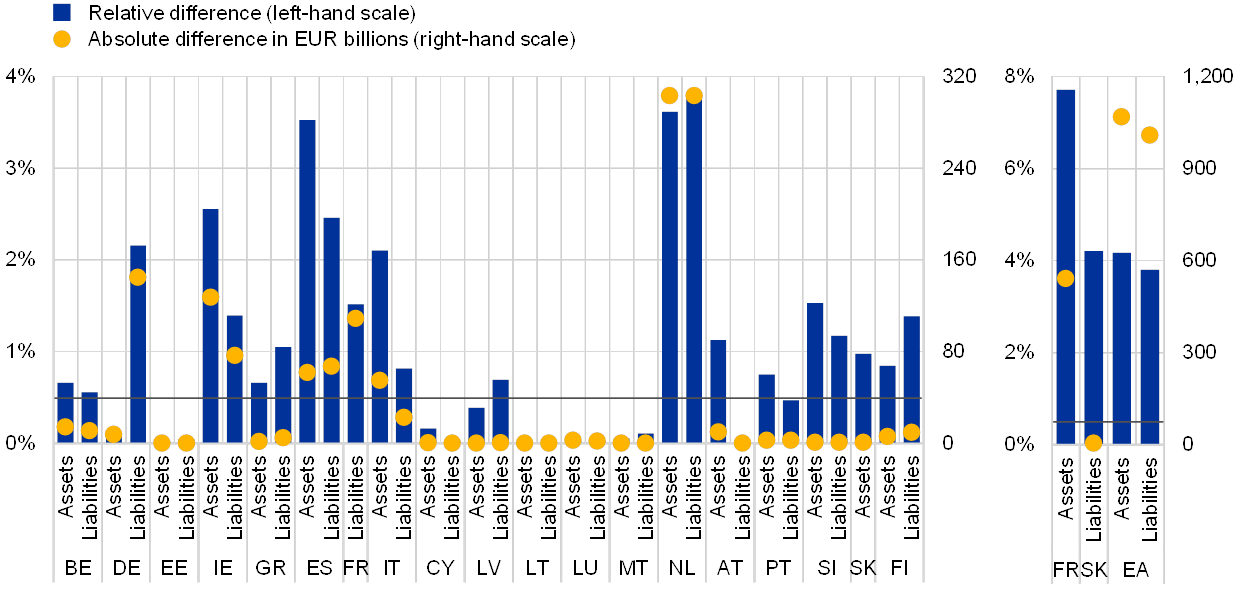
Source: ECB.
7.3 Comparison with other financial statistics
Deviations from other financial statistics may well be justified, as financial accountants may choose to amend the primary data sources in order to align with ESA concepts, or to enrich the data with alternative or supplementary data sources. However, identifying, comparing and explaining differences may be the starting point for a more thorough analysis and, in addition, explaining major differences between the national data and other related statistics provides valuable information for the users of euro area accounts and MIP data.
7.3.1 Comparison of MFI loans by counterpart sector with MFI balance sheet statistics
Conceptual differences arise for MFI loans because MFI balance sheet statistics (BSI) do not record the accrued interest with the loan. While unilateral write-downs may be recognised in MFI balance sheet statistics, loans are recorded at nominal value in the financial accounts until they have been completely written off.
Loans granted by MFIs to general government, as recorded in the financial accounts, may differ from the data in MFI balance sheet statistics because financial accounts compilers use government finance statistics, which are assumed to provide higher-quality identification of the borrowing entities classified in the government sector (while reporting MFIs may sometimes misclassify entities such as local utilities). This is the main reason why the loans granted by MFIs to NFCs may also differ in the financial accounts from BSI in a number of countries (see Annex 1 Table A.1.5.1). A further reason could be the recording of accrued interest, for which the preferred recording in the financial accounts is with the respective instrument, whereas in BSI it is recorded under remaining assets/liabilities). The differences are below 2% of stocks in most countries, although in Germany, the Netherlands and Austria the financial accounts data differ by more than 2%. In Germany and Austria this is due to the different sector allocation of MFI loans, while in the Netherlands it is due to the reclassification of certain securitised loans which has not yet been implemented in the case of the financial accounts as a different revision practice is followed.
7.3.2 Comparison of securities issuance and ECB securities issues statistics
Conceptual differences between securities issuance in the financial accounts and the securities issues statistics (SEC) relate to different valuation methods (nominal in SEC, market valuation in the financial accounts) and the recording of transactions received against payments other than cash. The latter can have a significant impact, particularly in the case of share swaps related to mergers and acquisitions. While share swaps are generally recorded in financial accounts as transactions, SEC does not record such transactions.
In some Member States securities issued without an International Securities Identification Number (ISIN), which is not generally captured in SEC, are non-negligible. Financial accounts compilers thus supplement the SEC for non-ISIN securities with additional information.
These methodological differences and the supplementation of securities issuance data with additional information may explain why the financial accounts values for stocks are mostly higher than the SEC values (see Annex 1 Table A.1.5.1). Small negative relative differences were observed in Estonia and the Netherlands, while the large positive relative differences seen for Cyprus were because the amounts for stocks were very close to zero.
Box 1 Quality indicators on financial accounts statistics underlying the MIP
The MIP scoreboard for the Alert Mechanism Report (AMR) consists of 14 headline indicators with thresholds (complemented by auxiliary indicators with no thresholds). The composition of the MIP indicators is subject to review and evolves over time in order to reflect the latest developments or increased data needs. Most of these indicators are composite, i.e. they make use of at least two data sources.
Financial accounts are the main input for the following three headline indicators:
- private sector debt[16], consolidated[17] as a percentage of GDP;
- private sector credit flow[18], consolidated as a percentage of GDP;
- financial sector liabilities[19], non-consolidated[20], one-year percentage change (11 years of data necessary);
- Additionally, financial accounts are used for one auxiliary indicator[21]:
- household debt (including NPISH) [22], consolidated as a percentage of GDP;
Institutional setup
Quarterly financial accounts are transmitted to the ECB on the basis of Guideline ECB/2013/24, with non-euro area EU Member States providing the data on a voluntary basis. Annual financial accounts are sent to Eurostat on the basis of ESA 2010 transmission programme (Regulation (EU) No 549/2013).The indicators used for the MIP are provided by Eurostat on the basis of the annual financial accounts compiled in the Member States by NCBs or, in some cases, by NSIs. In most cases the annual and quarterly financial accounts are derived from a single compilation system. A Memorandum of Understanding between Eurostat and the ECB/Directorate General Statistics (DG -S) on the quality assurance of statistics underlying the MIP (hereinafter “the MoU”) was therefore signed in November 2016. In the MoU (and in the letters that were exchanged), the European Commission and the ECB mutually recognise the quality assurance frameworks in place in the European Statistical System (ESS) and the ESCB and establish practical working arrangements for cooperation with regard to the quality assurance of statistics underlying the MIP.
The MoU specifies that Eurostat and the ECB/DG -S should regularly conduct assessments of the quality of the datasets. In particular, the ECB/DG -S should run its quality procedures for the datasets reported by NCBs and provide Eurostat with the quality-assured datasets and/or information on the quality of the data after the regular data transmission in September/October each year.[23] The MoU also envisages visits by the ECB/DG -S and Eurostat to NCBs and/or NSIs to help assess the output quality of MIP-relevant data. In 2018, two country visits took place and, as a result of the visits, recommendations for improving data quality were included in the relevant sections of the report.
To ensure full transparency with respect to the quality of MIP-related statistics, a three-level quality reporting system was set up over the last few years with the support of the Committee on Monetary, Financial and Balance of Payments Statistics (CMFB). The system consists of national self-assessment reports (Level 3) which, in turn, feed into the domain-specific quality reports (Level 2) – including this report – which are coordinated between the ECB and Eurostat. Finally, a joint Eurostat/ECB summary report assessing the quality of all statistics underpinning the MIP (Level 1) is published each year in the CMFB's section on Quality reports concerning statistics underlying the MIP indicators.
Data availability and confidentiality
All EU Member States provide quarterly financial accounts data which can be used to compile the MIP indicators on a non-consolidated basis (as these do not require who-to-whom data). The United Kingdom has not provided separate data for the insurance corporations (ICs) and pension funds (PFs) financial sub-sectors, although it does provide the data for the total financial corporations sector. As of October 2018 all euro area countries provide back data dating from Q1 1999 (or the first quarter of the year in which the respective country acceded to the European Union). Most non-euro area EU countries have also provided additional back data. For MIP purposes the focus is on data for the last ten complete years (2008 -17). 11 years are required (2007 -17) for the calculation of the financial sector liabilities (as a one-year percentage change). This data range was available for all EU countries except Denmark and Croatia. For Croatia quarterly financial accounts are not required for the years before it joined the European Union (before 2013)[24]. Longer time series (15 years) are preferable, and of the countries that joined the EU in 2004 or later, only Hungary provides quarterly back data prior to 2004.
All EU Member States make the full dataset foreseen for publication available to the general public, except for some minor exceptions which do not affect the compilation of the MIP indicator on a quarterly basis. Ireland releases the full counterpart sector details for securities, although parts of the data pre-dating Q1 2002 (and the separate households and non-profit institutions serving households (NPISH) sub-sectors for Q4 2012) are flagged as “not for publication”. In the case of Cyprus, the partial non-availability of more recent data and the counterpart sector details is due to primary and secondary confidentiality constraints in b.o.p./i.i.p. source data.
Sources and methods
The national financial accounts are generally consistent with the requirements and conceptual framework of ESA 2010. However, the financial account statistics are derived statistics that rely on a wide range of data sources which are not necessarily complete or fully sufficient in terms of conceptual requirements.
One area where the compilation of the financial accounts data underlying the MIP indicators is affected by limited data sources is the full coverage of financial sector liabilities, in particular special-purpose entities (SPEs) and, more generally, other financial institutions (OFIs), for which there are generally no source statistics in place which are both comprehensive and timely. Cross-checking with business registers or the use of other methods to ensure full coverage of OFIs should be improved in Germany, Cyprus (for SPEs), the Netherlands and Poland. While coverage is generally good in Spain, the time lag with regard to identifying new SPEs should be reduced. In the Czech Republic, Croatia and Sweden it is difficult to determine the coverage for particular OFI sub-sectors, groups of entities or instruments from the existing data sources. This may mean that these data are not fully covered – it is also not possible to estimate the missing data.
Several countries do not have a fully comprehensive direct data source for NFCs, or access to business registers facilitating the grossing-up procedures needed to achieve full coverage of intra-NFC loans and other transaction/positions not covered by counterpart sector information. Cross-checking with business registers or the use of other methods ensuring full coverage should be improved in Cyprus and Poland. Furthermore, Belgium, Bulgaria, the Czech Republic, Denmark, Germany, France, Croatia, Cyprus, Malta and Romania are encouraged to improve their timely direct data sources – this will reduce revisions when comprehensive data become available.
Accuracy and reliability
Revisions to the data underlying the MIP headline indicators are relatively low for most of the countries, as can be seen in the MIP Annex Table A.
For consolidated private sector debt and credit flow, revisions are mostly due to revisions to NFC loan financing, whereas revisions to household loan financing and the issuance of NFC debt securities are generally lower.
For consolidated private sector debt, revisions are relatively high in Belgium, Luxembourg, the Netherlands, Denmark and the United Kingdom, while the remaining countries have revisions that are lower than 2% of national GDP. These revisions are mainly due to new, improved data sources which have been updated. The exceptionally high revisions for the Netherlands are a result of the benchmark revisions in 2018 which led to the reclassification of a large amount of entities from other financial intermediaries to the NFC sector.
For consolidated private sector credit flow, revisions are relatively high in Belgium, Luxembourg, the Netherlands, the Czech Republic and the United Kingdom, while the remaining countries have revisions that are lower than 1% of national GDP. These revisions are mainly due to new, improved data sources which have been updated.
For total financial sector liabilities revisions are lower than 2% in most cases, measured as a one-year percentage change. The higher revisions observed for Denmark, Luxembourg, Malta and the Netherlands are mainly due to updated data sources. Moreover, financial sector liabilities continued to be revised upwards owing to the recording of additional SPEs in several countries. The size of these revisions differs between countries, partly reflecting the different economic realities and, in particular, the restructuring of multinationals.
For the auxiliary indicator on household debt, revisions are generally lower than they are for the headline indicators, mirroring the reliable main statistical source (loans by MFIs). The largest revisions (above 1% of GDP) are recorded for Luxembourg and Denmark.
Internal consistency
Most countries fulfil all validation (accounting) rules, with the minor exceptions of the Czech Republic, Denmark, Ireland, Croatia, Hungary, Romania, Sweden and the United Kingdom (see Annex 1 Table A.1.2.1). In the case of the United Kingdom observed inconsistencies are related to incomplete transmissions.
Consistency of quarterly and annual financial accounts
In most countries quarterly and annual financial accounts are fully consistent (see Annex 1 Table A.1.2.2). Vintage differences may occur as not all countries update their annual data on a quarterly basis. Countries are encouraged to ensure that quarterly and annual data are consistent, in particular for data vintages used for MIP purposes in October each year. Structural differences may signal quality issues in quarterly and/or annual accounts. Differences are relatively large in Ireland, Slovakia, Bulgaria, the Czech Republic and Denmark. While in these five countries different institutions are responsible for the compilation of annual and quarterly financial accounts (the NCB is responsible for the quarterly financial accounts and the NSI is responsible for the annual frequency), in other countries two institutions are responsible for the compilation of financial accounts yet the annual/quarterly data differences are very limited.
The different classification of certain financial institutions in quarterly and annual financial accounts explains some minor differences in financial sector liabilities in several countries. In Hungary the difference for financial sector liabilities (0.9%) is due to the different classification of the Hungarian Export-Import Bank (Eximbank) in quarterly and annual financial accounts, as transmitted by Hungary to the European institutions (the source for quarterly data is the NCB data sent to the ECB while the source for annual data is the data transmitted via Eurostat). Whereas the bank is included in the financial sector in the quarterly financial accounts, it is classified in the general government sector in the annual financial accounts. In its opinion of 17 July 2017 the CMFB advised that Eximbank should be classified in the general government sector.[25] [26]
Consistency with non-financial sector accounts
An important quality aspect for users of financial accounts is consistency with the non-financial accounts across institutional sectors. Conceptually, the net lending/net borrowing derived from the financial and the non-financial accounts should be identical for all sectors, although in practice this is often not the case. High and persistent differences signal quality issues in the financial and/or the non -financial accounts.
For the household sector vertical discrepancies for 2017 were above 2% of GDP in the Czech Republic, Greece, Romania, Slovenia, Finland, Poland and Sweden (see MIP Chart A).
MIP Chart A
Vertical discrepancies, households
(Absolute vertical discrepancies relative to GDP, percentages)
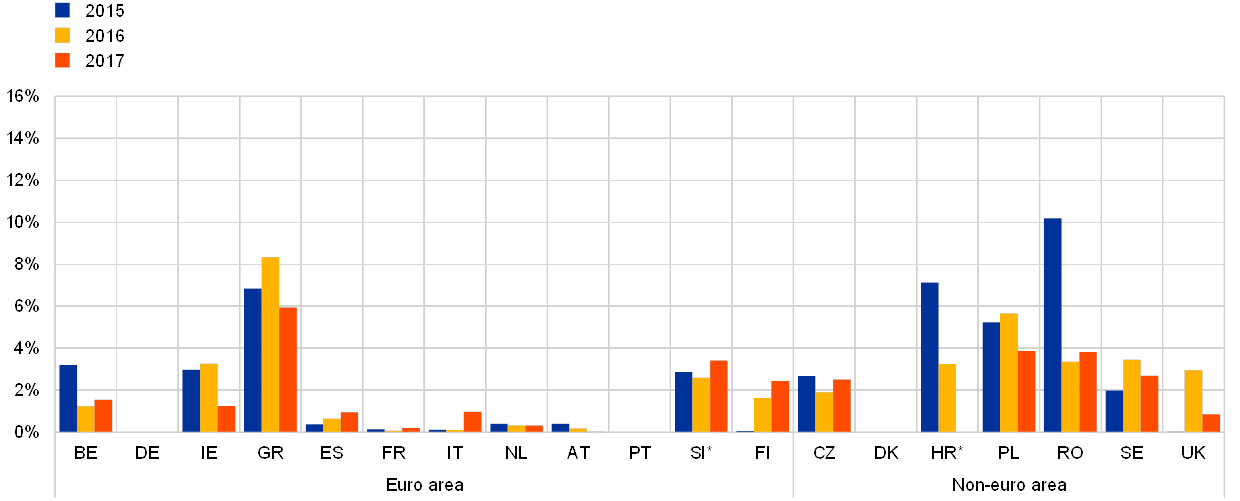
Note: * Quarterly non-financial sector accounts for this sector are provided by Slovenia and Croatia (up to and including data for 2016) on a voluntary basis.
MIP Chart B
Vertical discrepancies, non-financial corporations
(Absolute vertical discrepancies relative to GDP, percentages)
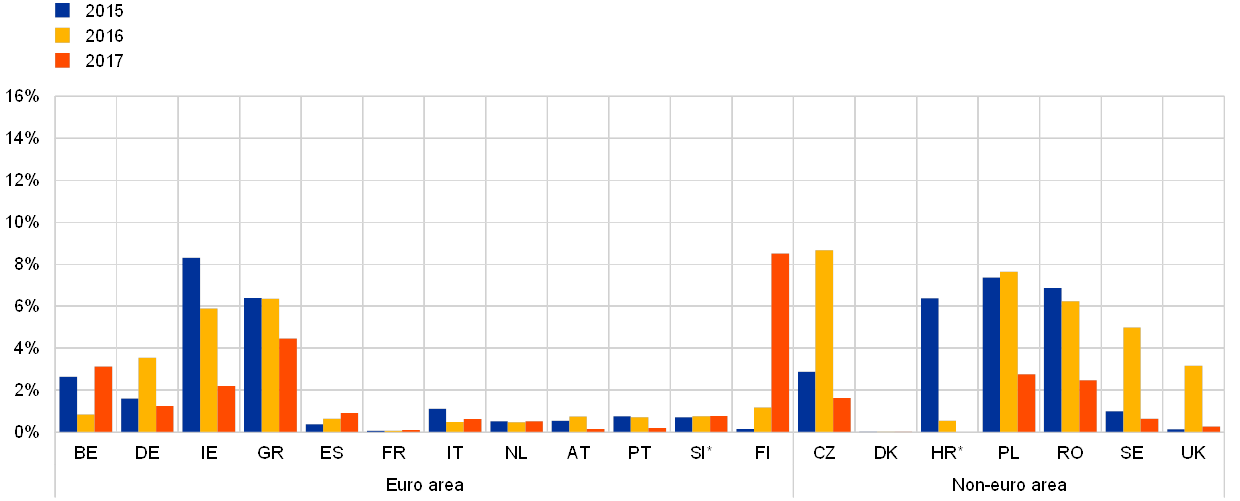
Note: * Quarterly non-financial sector accounts for this sector are provided by Slovenia and Croatia (up to 2016) on a voluntary basis.
For the NFC sector, vertical discrepancies for 2017 were above 2% of GDP in Belgium, Ireland, Greece, Finland, Poland and Romania (see MIP Chart B). In Finland, discrepancies increased in 2017 due to the process aimed at ensuring good alignment between balance of payments and financial accounts. This work will be continued together with balance of payments data compilers, to clarify the underlying causes.
MIP Chart C
Vertical discrepancies, financial corporations
(Absolute vertical discrepancies relative to GDP, percentages)

Note: * Quarterly non-financial sector accounts for this sector are provided by Slovenia and Croatia (up to and including data for 2016) on a voluntary basis.
For the financial corporations sector, vertical discrepancies for 2017 were above 2% of GDP in Ireland, Greece, the Czech Republic, Romania and Sweden (see MIP Chart C).
In several EU countries work to ensure good alignment between financial and non-financial accounts is being carried out, and regular meetings are being held between the compilers. At European level, the issue is addressed in the relevant working fora (WG FA, Expert Group on Sector Accounts).
MIP Annex Table A
Revisions
Revisions of financial accounts data underlying MIP indicators for 2016 (October 2018 transmission compared with October 2017 transmission)

Annexes
See more.
© European Central Bank, 2019
Postal address 60640 Frankfurt am Main, GermanyTelephone +49 69 1344 0Website www.ecb.europa.eu
All rights reserved. Reproduction for educational and non-commercial purposes is permitted provided that the source is acknowledged.
For specific terminology please refer to the ECB glossary (available in English only).
PDF ISBN 978-92-899-3841-9, ISSN 2363-0191, doi:10.2866/667294, QB-AV-19-001-EN-NHTML ISBN 978-92-899-3842-6, ISSN 2363-0191, doi:10.2866/805451, QB-AV-19-001-EN-Q
- [1]The principles underpinning this report can be found in the Public commitment on European Statistics by the ESCB. The ECB Statistics Quality Framework (SQF) and quality assurance procedures, published in April 2008, build upon the ESCB’s public commitment.
- [2]The SQF is available here.
- [3]The principles underpinning this report can be found in the Public commitment on European Statistics by the ESCB. The ECB Statistics Quality Framework (SQF) and quality assurance procedures, published in April 2008, build on the ESCB’s public commitment.
- [4]Guideline of the European Central Bank of 25 July 2013 on the statistical reporting requirements of the European Central Bank in the field of quarterly financial accounts (recast) (ECB/2013/24), OJ L 52, 7.1.2014, p. 34 (as amended).
- [5]The CMFB proposed that the harmonisation be extended to the financial accounts.
- [6]Quarterly data are available for most OFI subsectors except S.127; quarterly data for S.127 are estimated and interpolated based on annual data.
- [7]The OFI survey is a census survey and covers about 98% in terms of total amount of assets. The imputation of data from annual balance sheets for non-surveyed companies is planned for 2019.
- [8]“The ECB shall publish the euro area aggregates it compiles, as well as the ‘national data’ collected under Article 2, as described in paragraphs 3 to 5 thereof, as deemed relevant by the STC except for data relating to the cells in rows 12 -21 of Tables 3 to 9 of Annex I (referring to the counterpart sectors ‘residents in other euro area countries’ and ‘euro area RoW’)”. The STC confirmed in 2014 that all national financial accounts data required by the Guideline must be published, except as stated in the Guideline.
- [9]Internal consistency covers the following four elements: (i) aggregation consistency: total economy (transmitted sector total) = sum of sectors (sub-sectors); (ii) horizontal consistency: assets (sum of relevant sectors) = liabilities (sum of relevant sectors); (iii) balancing item consistency: transmitted net lending/net borrowing calculated from the financial accounts (B.9F) and net financial worth (BF.90) = assets (sum of relevant instruments) – liabilities (sum of relevant instruments); and (iv) counterpart sector consistency: totals (as reported in Tables 1 -2) = sum of relevant counterpart sectors (as reported in Tables 3 -7).
- [10]In order to compile appropriate euro area rest-of-the-world accounts, cross-border transactions and positions between euro area countries must be converted into domestic ones; for example, loans between non-financial corporations for two euro area countries are recorded as loans between non -financial corporations rather than loans to and from the rest of the world. However, in the national data of euro area countries, the bilateral transactions and positions do not always mirror each other. These “asymmetries” are eliminated in order to obtain a consistent set of euro area accounts.
- [11]Internal discrepancies of more than €10 million have been observed for a few countries but these were generally corrected in later transmissions.
- [12]Portugal will revise its recording of negative values for equity in the next benchmark revision (2019).
- [13]The harmonised EU revisions policy also supports equality between the two statistical domains.
- [14]Or at the time of the next European benchmark revision which, for most EU countries (20 out of 28), will also occur in 2019. The remaining countries either implemented it in 2018 or plan to do so in 2020.
- [15]For example, for unlisted equity in direct investment one dataset may use own funds at book value while the other dataset may use estimated market prices.
- [16]Private sector debt as defined in the MIP scoreboard is the stock of liabilities of the non-financial corporations (S.11) and households and non-profit institutions serving households (NPISH) sectors. The instruments taken into account to compile private sector debt are debt securities and loans.
- [17]i.e. not taking into account the stock (transactions, in the case of credit flow) of debt within the same sector.
- [18]Private sector credit flow refers to the net amount of liabilities that have incurred (transactions) in the non-financial corporations (S.11) and households and NPISH sectors during the year.
- [19]Total financial sector liabilities measure the evolution of the sum of all liabilities (which includes currency and deposits, debt securities, loans, equity and investment fund shares/units, insurance, pensions and standardised guarantee schemes, financial derivatives and employee stock options and other accounts payable) of the financial corporations sector.
- [20]i.e. taking into account the stock of liabilities within the same sector.
- [21]During 2018, the previous auxiliary indicator for the financial sector leverage sourced from the financial accounts was replaced by the banking sector leverage indicator from the Consolidated Banking Statistics and is therefore no longer included in this report. Similarly, the auxiliary indicator for non-consolidated private sector debt was replaced by consolidated household debt (including NPISH).
- [22]Non-profit institutions serving households.
- [23]The ECB runs its quality procedure on the quarterly financial accounts received from all EU Member States. According to the MoU it is then up to Eurostat to assess whether the quarterly data are comparable with the annual data it receives from a Member State. For a large majority of Member States the quarterly and annual accounts are the results of the same compilation system. The derivation of the MIP indicators by Eurostat is based on the annual financial accounts.
- [24]NCBs are not required to transmit data relative to quarters prior to the first quarter of the year in which the relevant Member State acceded to the European Union.
- [25]CMFB Opinion on the statistical sector classification of the Hungarian Export-Import Bank (Eximbank).
- [26]Magyar Nemzeti Bank publishes both quarterly and annual financial accounts that include Eximbank in the financial sector.


